Acer Aspire 3 (A314-22) review – decent budget offer
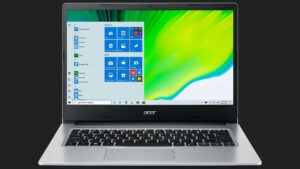 In this review, we’re going to show you an ultra-budget laptop and that is the Acer Aspire 3 (A314-22). Nope, this isn’t a fancy-looking device, this is an affordable daily driver or a working horse for the office. Believe it or not, this one has all the “ingredients” for normal usage.
In this review, we’re going to show you an ultra-budget laptop and that is the Acer Aspire 3 (A314-22). Nope, this isn’t a fancy-looking device, this is an affordable daily driver or a working horse for the office. Believe it or not, this one has all the “ingredients” for normal usage.
At first glance everything looks alright, you can pick it with a Full HD display, the device can be configured with more than 8GB of RAM, and there is an M.2 slot for fast NVMe drives that can boost the overall snappiness of the machine.
The laptop relies on rather old AMD Zen and Zen+ CPUs but for that kind of price, it seems like a logical decision. Still, there is a 4-core variant with 8 threads (Ryzen 5 3500U) which should be more than enough for browsing the Web, watching videos, some office tasks, and even light gaming.
The Acer Aspire 3 (A314-22) is a compact 14-incher – it’s decently light and its profile isn’t too thick so portability should not be a problem. The bezels around the display are thin enough and the laptop looks kind of modern (especially given the fact how affordable the device is).
Of course, we can spot some drawbacks out of the box – the build isn’t premium at all, the hardware platform is a bit outdated, and the presence of a 768p TN panel variant is a bit disturbing in 2021. Still, let’s see if this notebook can offer a lot of bang for the buck.
You can check the prices and configurations in our Specs System: https://laptopmedia.com/series/acer-aspire-3-a314-22/
Contents
Specs Sheet
- HDD/SSD
- up to 2000GB SSD + up to 1000GB HDD
- M.2 Slot
- 1x 2280 M.2 NVMe slot See photo
- RAM
- up to 20GB
- OS
- Windows 10 Home, Windows 11 Home, Windows 10 Pro, Windows 10 S, No OS
- Battery
- 36Wh, 2-cell, 37Wh, 37Wh, 4870 mAh, 48Wh, 36Wh, 2-cell , 36Wh
- Body material
- Plastic / Polycarbonate
- Dimensions
- 328 x 236 x 19.9 mm (12.91" x 9.29" x 0.78")
- Weight
- 1.90 kg (4.2 lbs)
- Ports and connectivity
- 1x USB Type-A
- 2.0
- 2x USB Type-A
- 3.2 Gen 1 (5 Gbps)
- HDMI
- Card reader
- Ethernet LAN
- 10, 100, 1000 Mbit/s
- Wi-Fi
- 802.11ac
- Audio jack
- 3.5 Combo Jack
- Features
- Fingerprint reader
- Backlit keyboard
- Microphone
- Speakers
- 2 Stereo Speakers
- Optical drive
- Security Lock slot
All Acer Aspire 3 (A314-22) configurations
What’s in the box?
The box contains just the usual stuff – the laptop, manuals, and a 45Wh power adapter.
Design and construction
As we said at the beginning of this article, this is a fairly compact budget 14-inch device. Here, we have a profile of 19.9mm and the laptop weighs 1.90 kilos – these specs are just okay if you have to take your laptop with you outside often.
Well, in terms of build quality, we have an all-plastic device, as expected in this price range. Luckily, the lid can be opened with a single hand but it’s a bit bouncy when you release it.
Yes, that’s the keyboard. It lacks a NumPad section and it doesn’t have a backlight. Moreover, the arrow keys are half-sized – too small for normal usage, and there are other keycaps that are too close to the arrows. The keyboard deck is bendable during hard typing, especially the area between the “Space” key and the touchpad. However, the keys provide good experience because they can offer decent travel and “click”.
Not much to say about the trackpad, it’s an average unit and it can do the job for everyday usage.
Ports
On the left side of the laptop, we can see a power adapter plug, an RJ-45 connector, an HDMI port, and two USB 3.1 Type-A (Gen. 1) ports. The right side has just and an audio jack, one USB Type-A 2.0 port, and a Kensington lock slot.
Disassembly, upgrade options and maintenance
The opening process of the Aspire 3 (A314-22) is easy – you have to undo 11 Phillips head screws and after that, you can pop the bottom panel with a plastic tool. The panel pops pretty easily, you don’t have to apply a significant amount of force.
The cooling is basic – it has one fan, one heat sink, and a single heat pipe.
In terms of upgradability, we have one RAM slot (there is a 4GB soldered memory) and an M.2 slot for NVMe drives – not bad for such a budget device.
The battery is a 37Wh unit which sounds normal for an affordable 14-incher.
Display quality
The Acer Aspire 3 (A314-22) we’re testing has a Full HD display, model number AUO B140HAN04.0 (AUO403D). Its diagonal is 14″ (35.56 cm), and the resolution – 1920 х 1080. Additionally, the screen ratio is 16:9, the pixel density – 157 ppi, their pitch – 0.161 x 0.161 mm. The screen can be considered Retina when viewed from at least 56 cm (from this distance, the average human eye can’t see the individual pixels).
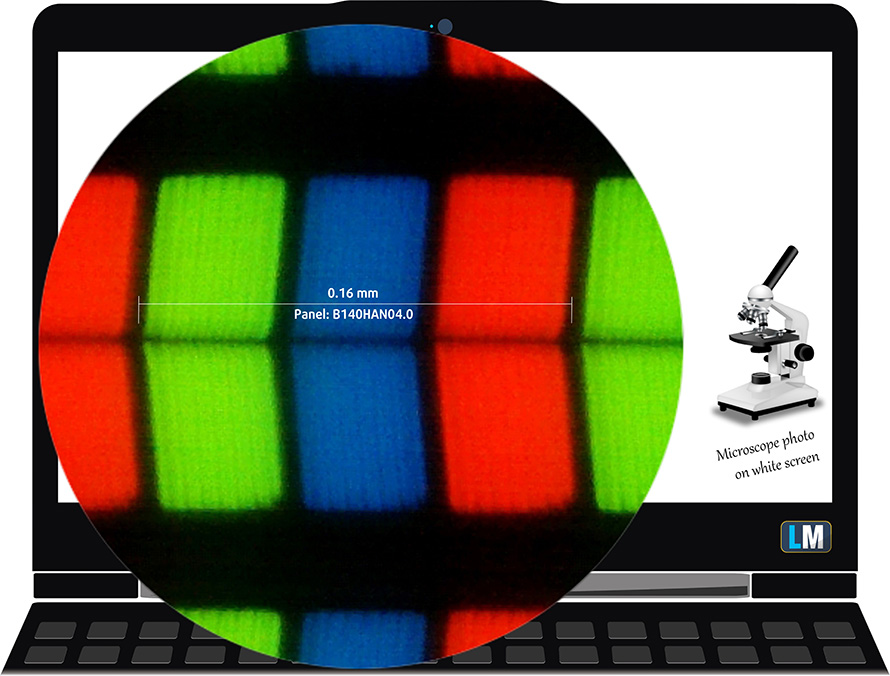
Its viewing angles are good. We have provided images at 45 degrees to evaluate quality.

The maximum measured brightness is 266 nits (cd/m2) in the middle of the screen and 250 nits (cd/m2) average across the surface with a maximum deviation of 8%. The Correlated Color Temperature on a white screen and at maximum brightness is 6680K (average) – slightly colder than the 6500K optimum for sRGB.
In the illustration below you can see how the display performs from a uniformity perspective.
Values of dE2000 over 4.0 should not occur, and this parameter is one of the first you should check if you intend to use the laptop for color-sensitive work (a maximum tolerance of 2.0 ). The contrast ratio is fine – 1470:1.
To make sure we are on the same page, we would like to give you a little introduction to the sRGB color gamut and the Adobe RGB. To start, there’s the CIE 1976 Uniform Chromaticity Diagram that represents the visible specter of colors by the human eye, giving you a better perception of the color gamut coverage and the color accuracy.
Inside the black triangle, you will see the standard color gamut (sRGB) that is being used by millions of people on HDTV and on the web. As for the Adobe RGB, this is used in professional cameras, monitors, etc for printing. Colors inside the black triangle are used by everyone and this is an essential part of the color quality and color accuracy of a mainstream notebook.
Still, we’ve included other color spaces like the famous DCI-P3 standard used by movie studios, as well as the digital UHD Rec.2020 standard. Rec.2020, however, is still a thing of the future and it’s difficult for today’s displays to cover that well. We’ve also included the so-called Michael Pointer gamut, or Pointer’s gamut, which represents the colors that naturally occur around us every day.
The yellow dotted line shows Acer Aspire 3 (A314-22)’s color gamut coverage.
Its display covers 52% of the sRGB/ITU-R BT.709 (web/HDTV standard) in CIE1976.

Our “Design and Gaming” profile delivers optimal color temperature (6500K) at 140 cd/m2 luminance and sRGB gamma mode.
We tested the accuracy of the display with 24 commonly used colors like light and dark human skin, blue sky, green grass, orange, etc. You can check out the results at factory condition and also, with the “Design and Gaming” profile.
Below you can compare the scores of Acer Aspire 3 (A314-22) with the default settings (left), and with the “Gaming and Web design” profile (right).
The next figure shows how well the display can reproduce dark parts of an image, which is essential when watching movies or playing games in low ambient light.
The left side of the image represents the display with stock settings, while the right one is with the “Gaming and Web Design” profile activated. On the horizontal axis, you will find the grayscale, and on the vertical axis – the luminance of the display. On the two graphs below you can easily check for yourself how your display handles the darkest nuances but keep in mind that this also depends on the settings of your current display, the calibration, the viewing angle, and the surrounding light conditions.

Response time (Gaming capabilities)
We test the reaction time of the pixels with the usual “black-to-white” and “white-to-black” methods from 10% to 90% and vice versa.
We recorded Fall Time + Rise Time = 31 ms
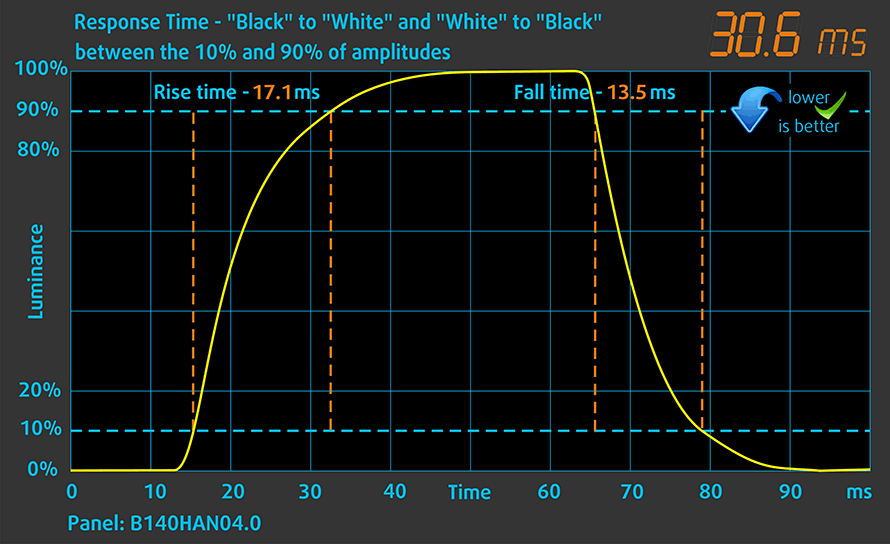
Health impact – PWM / Blue Light
PWM (Screen flickering)
Pulse-width modulation (PWM) is an easy way to control monitor brightness. When you lower the brightness, the light intensity of the backlight is not lowered, but instead turned off and on by the electronics with a frequency indistinguishable to the human eye. In these light impulses, the light/no-light time ratio varies, while brightness remains unchanged, which is harmful to your eyes. You can read more about that in our dedicated article on PWM.
Acer Aspire 3 (A314-22)’s panel is PWM-free. This is good news for people who will use this machine for prolonged periods of time.
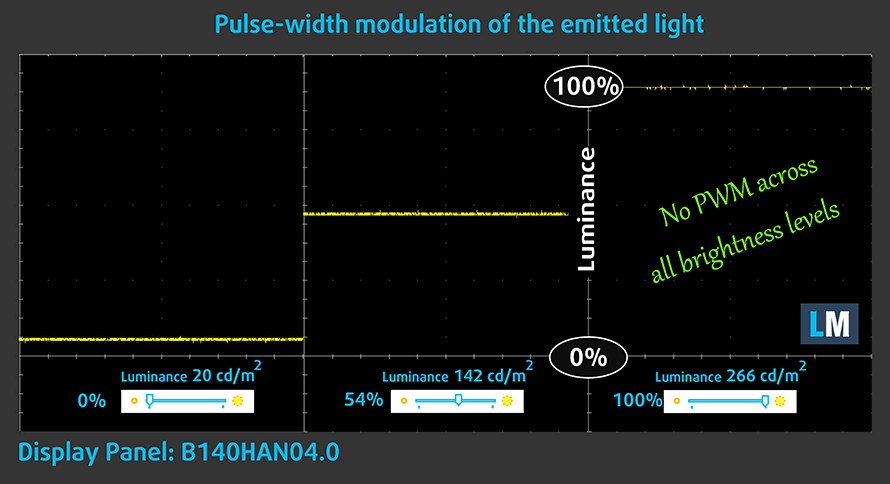
Blue light emissions
Installing our Health-Guard profile not only eliminates PWM but also reduces the harmful Blue Light emissions while keeping the colors of the screen perceptually accurate. If you’re not familiar with the Blue light, the TL;DR version is – emissions that negatively affect your eyes, skin, and your whole body. You can find more information about that in our dedicated article on Blue Light.
Buy our profiles
Since our profiles are tailored for each display model, this article and its respective profile package are meant for Acer Aspire 3 (A314-22) configurations with 14.0″ AUO B140HAN04.0 (AUO403D) (FHD, 1920 × 1080) IPS panel.
*Should you have problems with downloading the purchased file, try using a different browser to open the link you’ll receive via e-mail. If the download target is a .php file instead of an archive, change the file extension to .zip or contact us at [email protected].
Read more about the profiles HERE.
In addition to receiving efficient and health-friendly profiles, by buying LaptopMedia's products you also support the development of our labs, where we test devices in order to produce the most objective reviews possible.

Office Work
Office Work should be used mostly by users who spend most of the time looking at pieces of text, tables or just surfing. This profile aims to deliver better distinctness and clarity by keeping a flat gamma curve (2.20), native color temperature and perceptually accurate colors.

Design and Gaming
This profile is aimed at designers who work with colors professionally, and for games and movies as well. Design and Gaming takes display panels to their limits, making them as accurate as possible in the sRGB IEC61966-2-1 standard for Web and HDTV, at white point D65.

Health-Guard
Health-Guard eliminates the harmful Pulse-Width Modulation (PWM) and reduces the negative Blue Light which affects our eyes and body. Since it’s custom tailored for every panel, it manages to keep the colors perceptually accurate. Health-Guard simulates paper so the pressure on the eyes is greatly reduced.
Get all 3 profiles with 33% discount
Sound
Acer Aspire 3 (A314-22)’s speakers can produce a sound with decent quality. Its low, mid, and high tones are clear of deviations.
Drivers
You can download all of the drivers and utilities for this notebook here: https://www.acer.com/ac/en/US/content/support-product/8402?b=1
Battery
Now, we conduct the battery tests with Windows Better performance setting turned on, screen brightness adjusted to 120 nits, and all other programs turned off except for the one we are testing the notebook with. The results are pretty positive – we got 7 hours and 9 minutes for both Web browsing and video playback.
In order to simulate real-life conditions, we used our own script for automatic web browsing through over 70 websites.

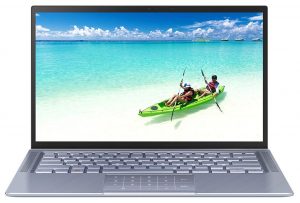
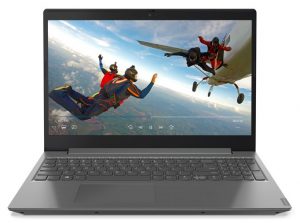
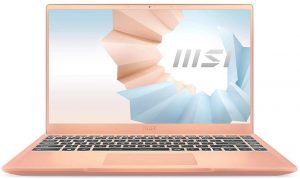
For every test like this, we use the same video in HD.




CPU options
The Acer Aspire 3 (A314-22) comes with the following CPU options – AMD 3020e, AMD Ryzen 3 3250U, and AMD Ryzen 5 3500U. These AMD Zen and Zen+ variants are a bit outdated but they can still offer good performance for causal daily tasks if you combine them with at least 8GB of RAM.
Results are from the Cinebench 20 CPU test (the higher the score, the better)
Results are from our Photoshop benchmark test (the lower the score, the better)
Acer Aspire 3 (A314-22) CPU variants
Here you can see an approximate comparison between the CPUs that can be found in the Acer Aspire 3 (A314-22) models on the market. This way you can decide for yourself which Acer Aspire 3 (A314-22) model is the best bang for your buck.
Note: The chart shows the cheapest different CPU configurations so you should check what the other specifications of these laptops are by clicking on the laptop’s name / CPU.
Results are from the Cinebench R23 CPU test (the higher the score, the better)
Results are from our Photoshop benchmark test (the lower the score, the better)
GPU options
Only iGPUs here, like it or not, you’re stuck with AMD RX Vega 3 or AMD Radeon RX Vega 8 (Ryzen 2000/3000, 15W).
Results are from the 3DMark: Time Spy (Graphics) benchmark (higher the score, the better)
Results are from the 3DMark: Fire Strike (Graphics) benchmark (higher the score, the better)
Results are from the Unigine Superposition benchmark (higher the score, the better)
Gaming tests
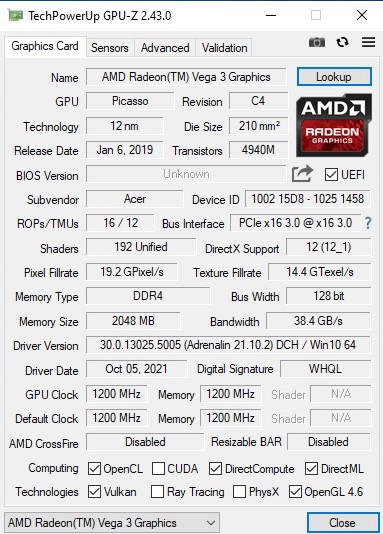

| CS:GO | HD 1080p, Low (Check settings) | HD 1080p, Medium (Check settings) | HD 1080p, MAX (Check settings) |
|---|---|---|---|
| Average FPS | 59 fps | 42 fps | 29 fps |

| DOTA 2 | HD 1080p, Low (Check settings) | HD 1080p, Normal (Check settings) | HD 1080p, High (Check settings) |
|---|---|---|---|
| Average FPS | 62 fps | 67 fps | 20 fps |
Temperatures and comfort
Max CPU load
In this test we use 100% on the CPU cores, monitoring their frequencies and chip temperature. The first column shows a computer’s reaction to a short load (2-10 seconds), the second column simulates a serious task (between 15 and 30 seconds), and the third column is a good indicator of how good the laptop is for long loads such as video rendering.
Average core frequency (base frequency + X); CPU temp.
| AMD Ryzen 5 3250U (15W TDP) | 0:02 – 0:10 sec | 0:15 – 0:30 sec | 10:00 – 15:00 min |
|---|---|---|---|
| Acer Aspire 3 (A314-22) | 3.11 GHz (B+20%) @ 90°C @ 21W | 2.94 GHz (B+13%) @ 89°C @ 16W | 2.85 GHz (B+10%) @ 86°C @ 17W |
The cooling solution struggles even with a dual-core CPU like the AMD Ryzen 5 3250U. Sure, the processor always boosts above its base clock but the CPU temperature reaches 90°C in short loads and it stabilizes around 86°C during heavy usage.
Gaming comfort
No matter what you’re doing, you can always hear the cooling fan, and when heavily loaded it becomes quite noisy. The fan spins audibly even when you want to install some small program for 10 seconds. During load, the left side of the keyboard and the palm rest area are always warm, but not too much.
Verdict
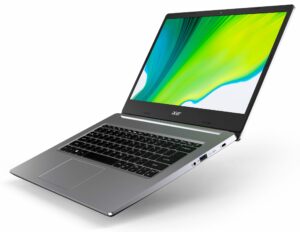 Actually, for that kind of price tag, this device is a decent offer. It’s compact so portability is okay. It’s a 14-inch laptop and it’ll fit in most backpacks with ease. The bezels around the display are narrow (except for the “chin”) and the laptop looks up-to-date, especially for its price category.
Actually, for that kind of price tag, this device is a decent offer. It’s compact so portability is okay. It’s a 14-inch laptop and it’ll fit in most backpacks with ease. The bezels around the display are narrow (except for the “chin”) and the laptop looks up-to-date, especially for its price category.
Hardware-wise, the choice is entirely in your hands. If you want a bit more future-proof machine, the AMD Ryzen 5 3500U is the logical choice and the AMD Radeon RX Vega 8 (Ryzen 2000/3000, 15W) is good enough to play some light games on Low settings like League Of Legends or Rocket League. The device that we have bought has an AMD Ryzen 3 3250U, 2x4GB RAM, and AMD RX Vega 3 under the hood.
Well, it’s not a beast with its 4-thread CPU but it’s fine for Web browsing and video content. We didn’t experience any negative effects like freezes, lags, or low performance during testing. On the other hand, the low-powered AMD 3020e should be avoided because it’s not just 2-core but it also lacks SMT (ergo, it doesn’t have additional logical cores). This CPU should be only chosen if you have a super-tight budget…and you have to buy a laptop now…and there are no other options.
The upgradability options are good given the price tag of the laptop. It offers one SODIMM (in addition to the soldered RAM) and a single M.2 slot – it’s not bad at all. At least you can take advantage of dual-channel memory and NVMe drives. Another pro of the notebook is the optional Full HD display (AUO B140HAN04.0 (AUO403D)) – it’s an IPS unit that has good viewing angles and it’s PWM-free so it’ll not impact your health in prolonged periods of usage. Another thing that surprises us in a good way is the device’s battery life – the small 37Wh unit is good enough for more than 7 hours of Web browsing or video playback – neat.
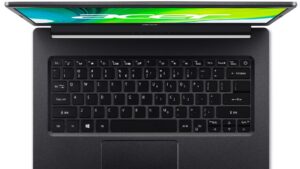 Sure, the Acer Aspire 3 (A314-22) has some drawbacks. It has an all-plastic build, the lid bounces around when you release it, the keyboard lacks a backlight and NumPad area, and it’s bendy during typing.
Sure, the Acer Aspire 3 (A314-22) has some drawbacks. It has an all-plastic build, the lid bounces around when you release it, the keyboard lacks a backlight and NumPad area, and it’s bendy during typing.
The modest cooling solution can keep reasonable clocks during load but the CPU is always hot and the fan produces a lot of noise in almost any situation. Sadly, the I/O has just a few ports. And yes, the Full HD IPS display has low sRGB coverage but that’s not a big deal if you don’t use it for color-sensitive work.
However, for that kind of money, the Acer Aspire 3 (A314-22) is a solid offer. Just be careful how you configure it before buying – if you choose the 1080p panel with at least AMD Ryzen 3 3250U and 8GB of RAM (keep in mind that the dual-channel mode boosts the overall performance) you’ll get a decent budget device that can be your daily driver if you aren’t too pretentious.
You can check the prices and configurations in our Specs System: https://laptopmedia.com/series/acer-aspire-3-a314-22/
Pros
- Compact – 19.9 mm, 1.90 kg (0.78″, 4.19 lbs)
- Affordable
- Decent upgradability options for its class
- Doesn’t use PWM for brightness adjustment (AUO B140HAN04.0, AUO403D)
- The display has a good contrast ratio and comfortable viewing angles (AUO B140HAN04.0, AUO403D)
- Good battery life
Cons
- Mediocre build quality
- No Type-C port, nor an SD card reader
- The IPS panel has low sRGB color coverage (AUO B140HAN04.0, AUO403D)
- The keyboard lack backlight and a NumberPad
- Unimpressive amount of ports


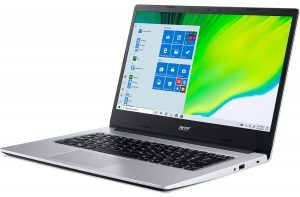

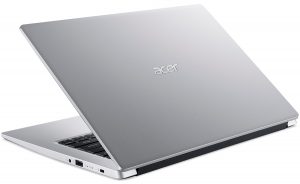
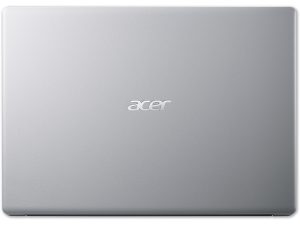
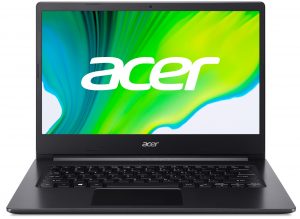
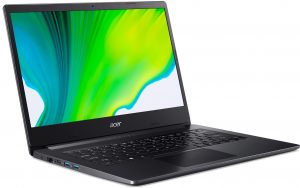
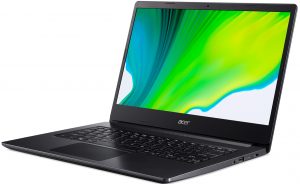
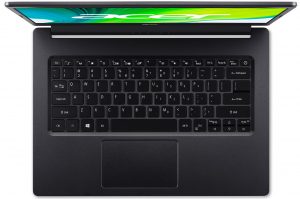
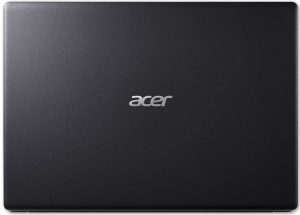
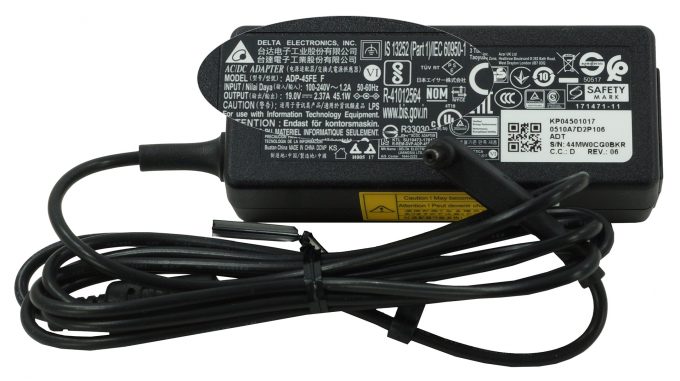
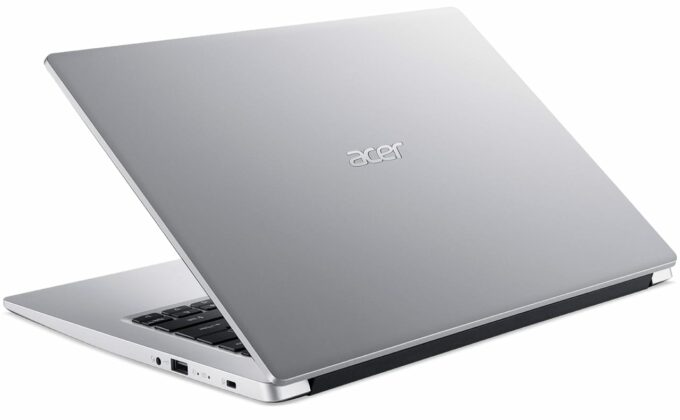

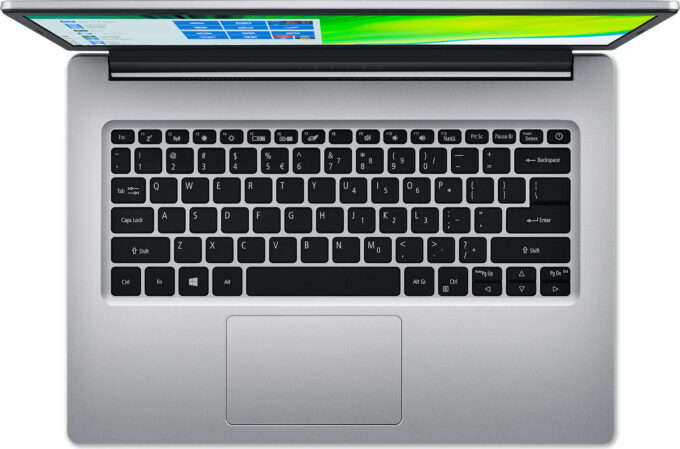


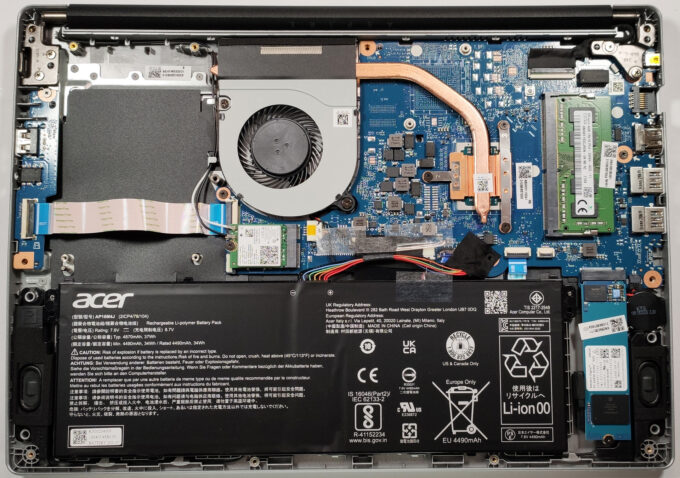
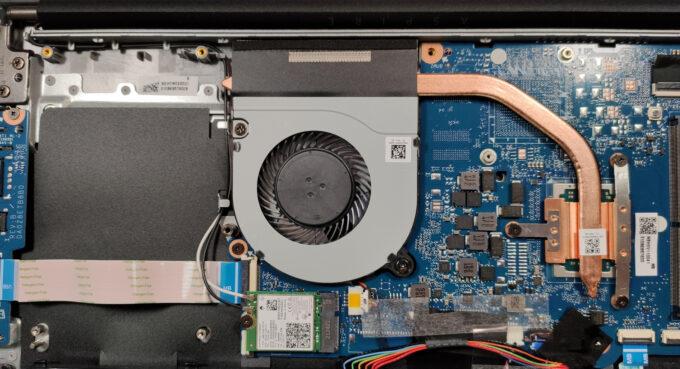
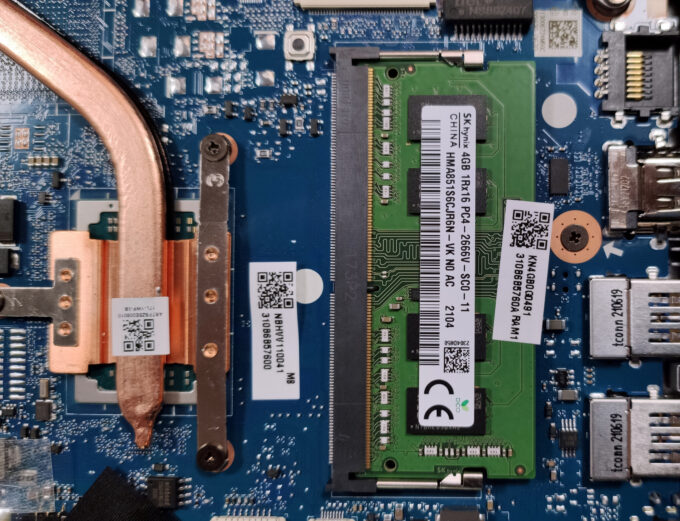

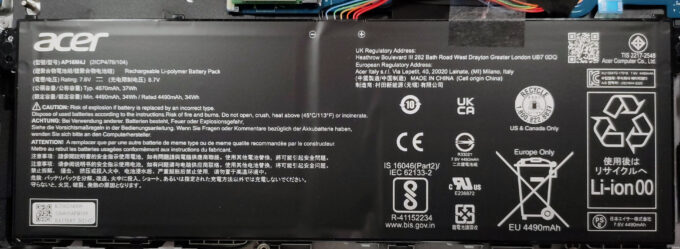
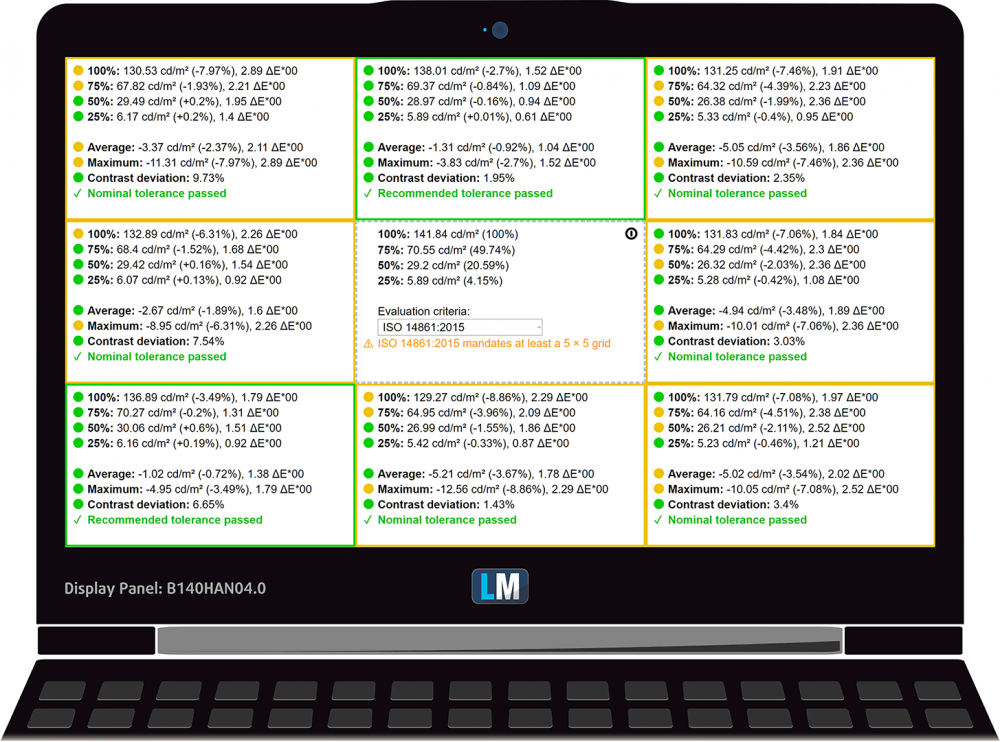
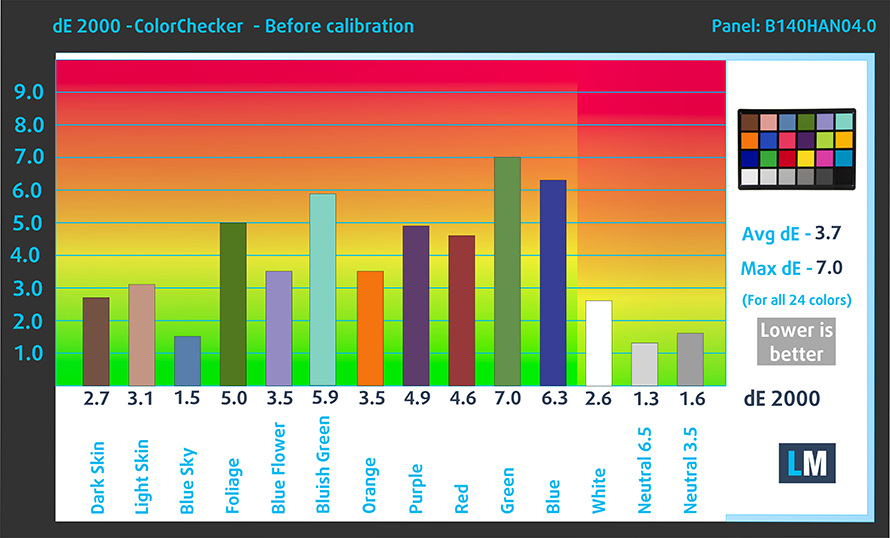
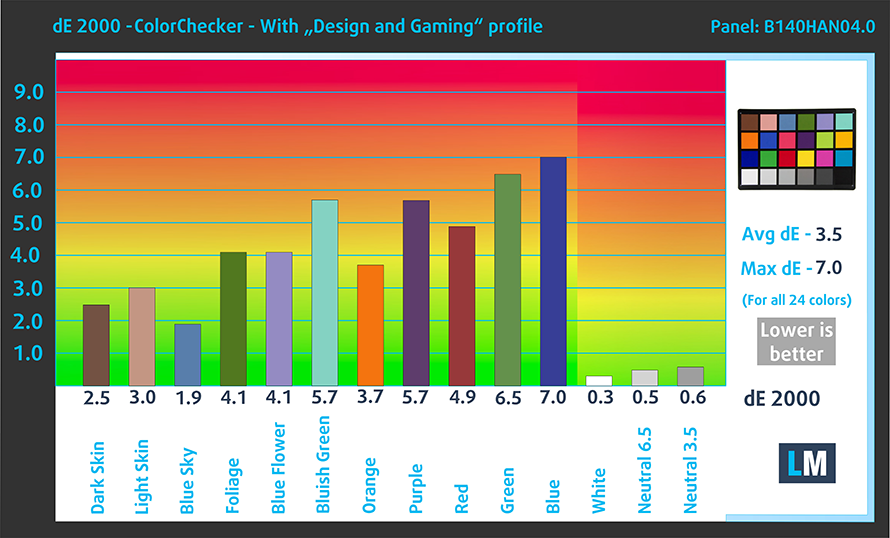

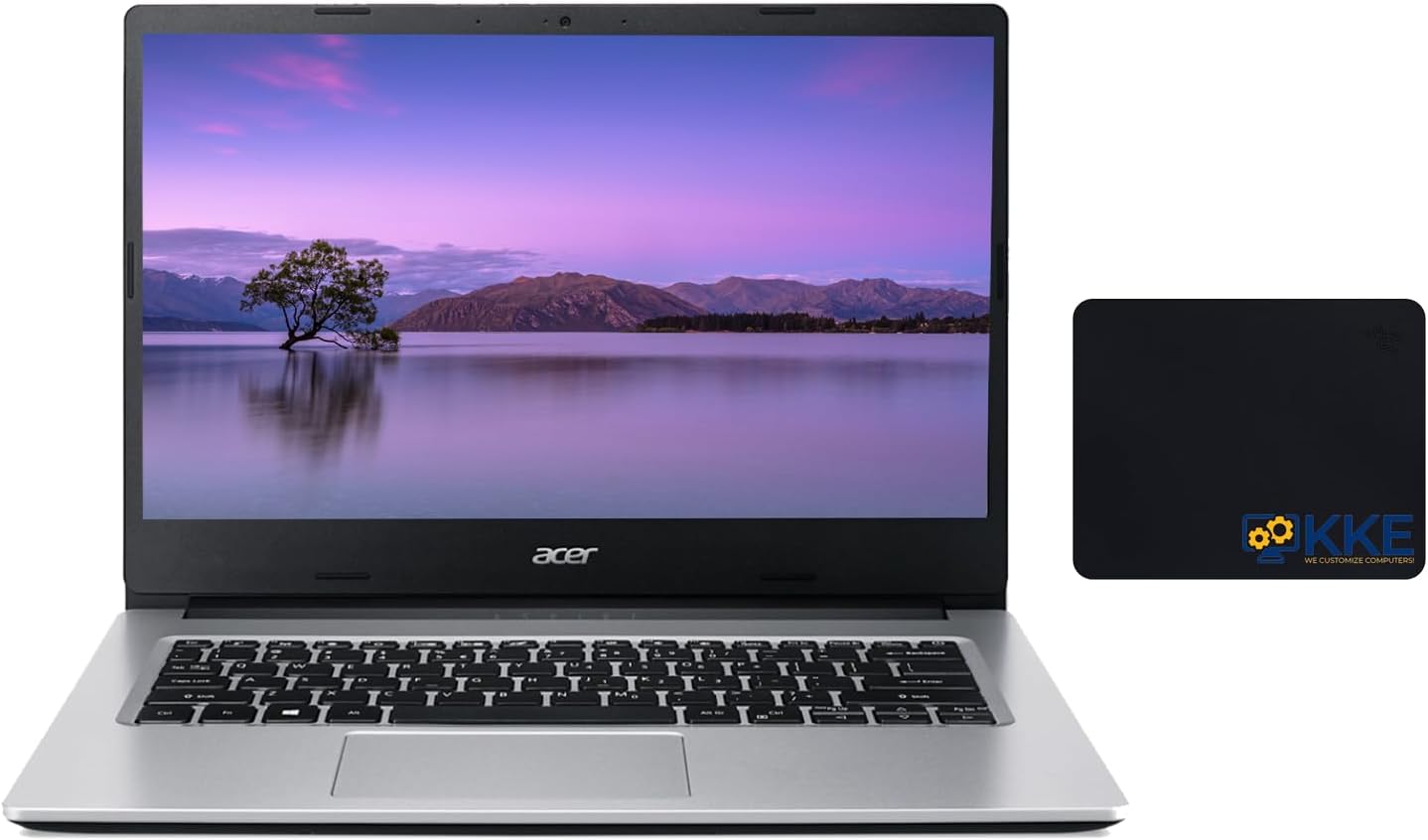








Hello, i have the AMD Ryzen 5 3500U with vega 8 and i need advice, i want to improve the ram, what do you recommend. also, what other recomendations do you suggest?